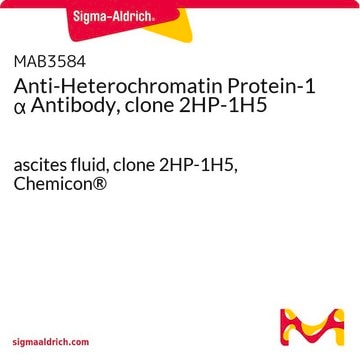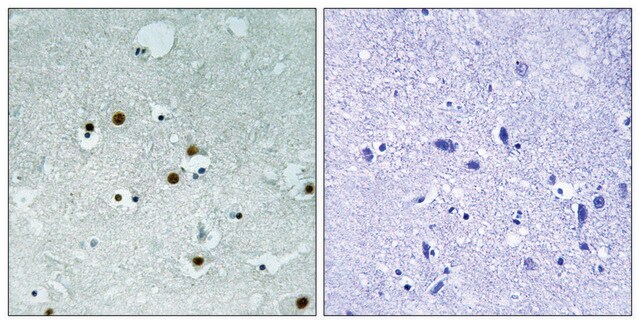05-689
Anti-HP1α Antibody, clone15.19s2
clone 15.19s2, Upstate®, from mouse
Sinonimo/i:
Antigen p25, HP1 alpha, HP1Hs alpha, Heterochromatin protein 1 homolog alpha, chromobox homolog 5 (Drosophila HP1 alpha), chromobox homolog 5 (HP1 alpha homolog, Drosophila), heterochromatin protein 1-alpha
About This Item
Prodotti consigliati
Origine biologica
mouse
Livello qualitativo
Forma dell’anticorpo
purified immunoglobulin
Tipo di anticorpo
primary antibodies
Clone
15.19s2, monoclonal
Reattività contro le specie
mouse, vertebrates, human
Produttore/marchio commerciale
Upstate®
tecniche
ChIP: suitable
immunocytochemistry: suitable
immunohistochemistry: suitable
immunoprecipitation (IP): suitable
western blot: suitable
Isotipo
IgG1
N° accesso NCBI
N° accesso UniProt
Condizioni di spedizione
wet ice
modifica post-traduzionali bersaglio
unmodified
Informazioni sul gene
human ... CBX5(23468)
Descrizione generale
Specificità
Immunogeno
Applicazioni
A previous lot of this antibody has been reported by an independent laboratory to detect HP1a in NIH/3T3 nuclei (Ayyanathan, K., 2003).
Immunoprecipitation/Chromatin Immunoprecipitation:
A previous lot of this antibody has been reported by an independent laboratory to immunoprecipitate HP1α from nuclear extracts and formalin-cross-linked chromatin (Ayyanathan, K., 2003).
Epigenetics & Nuclear Function
Chromatin Biology
RNA Binding Protein (RBP)
Qualità
Western Blot Analysis:
0.5-2 µg/mL of this lot detected HP1α protein in acid-extracted HeLa cell lysates.
Descrizione del bersaglio
Linkage
Stato fisico
Stoccaggio e stabilità
Handling Recommendations:
Upon receipt, and prior to removing the cap, centrifuge the vial and gently mix the solution. Aliquot into microcentrifuge tubes and store at -20°C. Avoid repeated freeze/thaw cycles, which may damage IgG and affect product performance.
Risultati analitici
HeLa, NIH/3T3 and COS cell lysates.
Altre note
Note legali
Esclusione di responsabilità
Not finding the right product?
Try our Motore di ricerca dei prodotti.
Codice della classe di stoccaggio
12 - Non Combustible Liquids
Classe di pericolosità dell'acqua (WGK)
WGK 1
Punto d’infiammabilità (°F)
Not applicable
Punto d’infiammabilità (°C)
Not applicable
Certificati d'analisi (COA)
Cerca il Certificati d'analisi (COA) digitando il numero di lotto/batch corrispondente. I numeri di lotto o di batch sono stampati sull'etichetta dei prodotti dopo la parola ‘Lotto’ o ‘Batch’.
Possiedi già questo prodotto?
I documenti relativi ai prodotti acquistati recentemente sono disponibili nell’Archivio dei documenti.
Il team dei nostri ricercatori vanta grande esperienza in tutte le aree della ricerca quali Life Science, scienza dei materiali, sintesi chimica, cromatografia, discipline analitiche, ecc..
Contatta l'Assistenza Tecnica.








